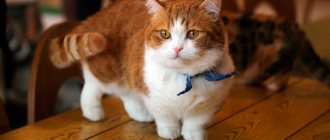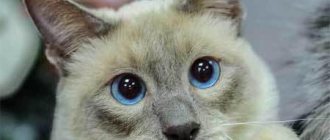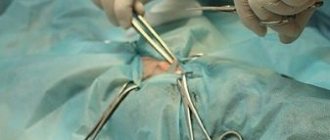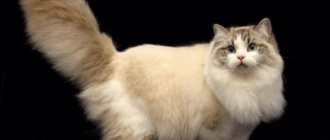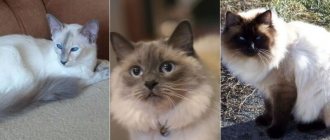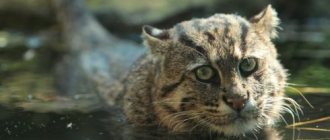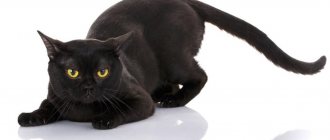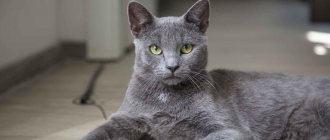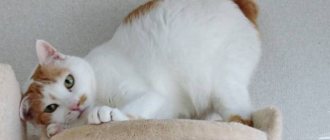Origin story
Until the end of the 80s. Most experts believed that the short-legged animal was inferior and unhealthy. The Munchkin, as an independent variety, began to develop in 1983.
In Louisiana, Sandra Hochenedel picked up a street cat with abnormally short legs. The woman believed that this feature was related to her lifestyle: she ate poorly and could not develop normally.
However, the cat gave birth to kittens with the same short legs. The owner was very surprised and gave one female from the litter to her friend. After a while, she also gave birth to short-legged babies. Sandra thought about this amazing phenomenon and turned to a veterinarian.
Studies were carried out, after which the veterinarian concluded that the peculiarity of the structure of the animal’s legs was due to a mutation in the genetic code. It was found that this is not a defect and does not affect health.
The description of the Munchkin breed was compiled two years after the appearance of the first offspring. Many breeders continued to consider the animals inferior and ugly. However, in 1995 they began to be presented at exhibitions.
Character of the munchkin breed
Munchkins are a breed of cat whose character is affectionate, friendly and sociable. They are very obedient and flexible. Despite their positive character traits, short-legged animals run a lot and quickly.
At the same time, they sway a little. Cats become especially playful and active when playing with people. Their voice is weak. And in general, the character of the munchkin breed is such that he very rarely gives a voice.
Cats have a lot of patience. If they are squeezed by small children, they do not release their claws. They may scratch the child if it becomes impossible to tolerate.
Little short-legged cats are a real bundle of energy. It feels like the munchkins are in different places at the same time, they are so maneuverable and fast. Timidity and fear are alien to them.
On the contrary, munchkins are inquisitive. They will certainly explore all corners of the home and visit everywhere, even if it is not possible to get there.
Surprisingly, the animal often tries to steal something it likes in order to hide it in a secluded place.
Often, a cat that looks like a dachshund can resemble a meerkat or kangaroo. During the day, the pet sits down on its hind legs several times. At the same time, it extends the forelimbs forward.
In this case, the tail serves to maintain balance. In a sitting position, the cat has a better view of the surrounding environment. Short-legged Munchiquin cats are playful, sociable, smart, and love to hunt.
Distinctive features
The breed appeared relatively recently, so its standard has not yet been fully formed. However, the basic characteristics are already there:
| Sign | Description |
| Head | Wide, with smooth outlines, wedge-shaped. Proportional to the body. In adult males it is more developed than in females. |
| Nose | Average, slight bend allowed. |
| Ears | Located high. Fluffy, wide at the base, rounded at the tips. |
| Eyes | They have the shape of a walnut. Located widely, at a slight angle to the ears. The shade depends on the color of the coat. |
| Neck | Thickened and muscular, of medium length. |
| Torso | Medium size. |
| Paws | The hind ones are slightly longer than the front ones. It is permissible to bend the latter towards the inside. Limbs are straight. |
| Backbone | Not heavy, but not lightweight. |
| Muscles | Well developed. |
| Tail | Equal to the length of the body. Stands upright when moving. |
| Weight | In males - 3-4 kg. In females - 2-3.6 kg. |
| Wool | Short: shiny, plush to the touch. Long: dense and silky with a lordly collar. |
| Coloring | Any colors and combinations. |
Colors of short-legged cats
There are no restrictions on color - it can be red, smoky, as well as silver and black. Long-haired species often have bicolor colors.
Bicolor is a popular color type among the Munchkin breed.
The colors of short-haired breeds are also unlimited; Siamese, spotted and patterned tabby colors are often found among them.
The colors of shorthaired munchkins also have no restrictions.
Nutrition
The number of meals depends on the age of the pet:
- up to four weeks - five times a day;
- from twelve weeks to one year - three or four times;
- adults - twice.
Up to four months it is necessary to give porridge, meat, and fermented milk products. The diet of adults includes vegetables and fish fillets.
Premium dry and wet food and holistic foods are recommended.
Required products on the menu:
- unsweetened fermented milk products without dyes and synthetic thickeners;
- dietary meat;
- sea fish;
- cereals, excluding legumes;
- vegetables, except potatoes;
- chicken and quail yolks;
- meat by-products (for example, liver).
Fish and meat should be boiled and mixed into porridge. Vegetables are not fully digestible by animals. This must be taken into account when creating a menu.
Hygiene
Munchkins come in long-haired and short-haired varieties. Pets should be combed with a slicker brush, comb, or brush. The movement is from head to tail. Done once a week.
Wash cats if necessary. A special shampoo is used, selected according to the type of coat and skin. After bathing, the pet is dried with a soft cloth or dried with a hairdryer.
Munchkin's eyes are treated with a cotton pad soaked in boiled water or tea. Teeth are brushed every two weeks with cat toothpaste. Wax and accumulations of dirt from the ears are removed with cotton swabs with a special solution or drops, Vaseline. The claws are trimmed as they grow with a nail clipper.
Fun facts
- Previously, munchkins in Russia were called the Stalingrad kangaroo cat due to the fact that they often squat or stand on their hind legs.
- A tortoiseshell munchkin from California (USA) named Lilliputian is considered the shortest cat in the world according to the 2013 Guinness Book of Records, as his height is only 14.02 cm.
- These pets' love for stealing shiny objects has led to them being called "magpie cats."
- Because their short legs are a genetic mutation, munchkin cats are not interbred. They are born into a “normal” litter of kittens.
Based on materials from www.blog.kohepets.com.sg
Health
Munchkins are hardy and healthy. They have a strong immune system and no predisposition to severe genetic pathologies.
A hereditary disease to which the breed is susceptible is lordosis of the spine in the form of its stretching in the thoracic region.
The pathological condition provokes problems with the heart and lungs. Most often, the disease manifests itself in obesity or genetic characteristics. Therefore, it is important to monitor your pet’s diet and carefully choose a partner when mating.
Breed faults:
- convex chest;
- too round head and eyes;
- absence of tail, fingers, polydactyly;
- snub or elongated nose;
- “cow set”;
- short, very stocky body;
- curly hair;
- concave back, drooping croup;
- absence of testes;
- blindness and strabismus.
Also, a cat will be disqualified at an exhibition if it has a difficult character, cowardice, or aggressiveness.
Hybrids
Munchkins are crossed with other breeds. As a result, many types appeared:
- Napoleon is a hybrid with a Persian and an exotic;
- Skookum is a hybrid with laperm;
- Kinkalow - appeared after crossing with the American Curl;
- Bambino is a hybrid with the Canadian Sphynx;
- Genetta - connection with the Bengal cat;
- Minskin – Devon Rex, Sphynx, Burmese took part;
- Dwelf is the result of crossing with the Canadian Sphynx, American Curl;
- Lamkin is one of the parents of the Selkirk Rex;
- Mei Toy is the result of a connection with the Ocicat and the Singapura;
- Munchbob - a mix with bobtails led to the appearance of small cats with short tails and legs.
All varieties are called by one common word "dwarves", which means gnomes. There is a Fold Munchkin or a Scottish Fold Munchkin (one of the parents is a Scottish Fold). However, this variety is not recognized as a breed and is the result of the activities of enthusiasts.
Advantages and disadvantages
The breed has many more positive aspects than negative aspects:
| Advantages | Flaws |
| Obedient, good-natured, smart. | They have a habit of hiding things. |
| They calmly accept changes and new surroundings. | They don't catch rodents. |
| They rarely get sick. | You should not be allowed out for walks unattended. |
| They don’t jump on tables or cabinets, so they don’t hit fragile things or steal food. | If you don't hide the toys, they wake you up at night. |
| Do not require special care. | |
| Not picky eaters. | |
| Do not spoil indoor flowers. | |
| They are good with children and other pets. | |
| Not intrusive. | |
| Not aggressive. | |
| They rarely meow. |
What causes the appearance of short-legged cats?
The appearance of a new breed of cats with short legs predetermined the extensive work of breeders to breed new species of these animals. But before that, felinologists tried to study the reason for the short legs of cats.
IMPORTANT: short-legged cats do not have concomitant diseases, the peculiarity of their structure does not give the cat pain or other negative manifestations.
Short-legged animals are great lovers of life
Research results have revealed that the achondroplasia gene is responsible for “short legs” - this is a gene for congenital dwarfism in combination with unusually short legs. The remaining organs, bones and overall health of the animals are not affected by this gene, which is a random glitch in the cat’s genome. Short-legged cats are completely healthy and move without problems on their unusual paws.
Price
When deciding to buy a kitten, you need to pay attention to the following:
- age of parents;
- number of matings between father and mother;
- diseases of parents, hereditary pathologies;
- features of pregnancy and childbirth;
- absence of individuals with extra toes in the litter;
- availability of certificates of vaccinations and deworming in accordance with age;
- sterilization and castration;
- behavioral characteristics of the kitten and its parents;
- food given to the animal;
- content rules.
A kitten without documents costs between 15-25 thousand rubles.
Purebred individuals - 40-60 thousand rubles. The price of animals in high-level nurseries is determined by experts. Lilieput – Shortest Cat Guinness World Records 2014 Photo Credit: James Ellerker/Guinness World Records 1111
